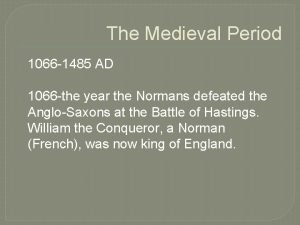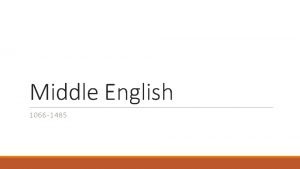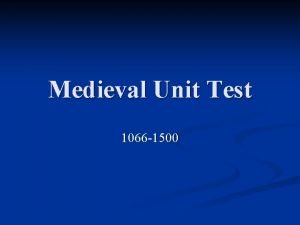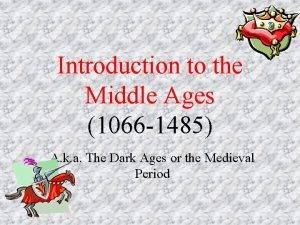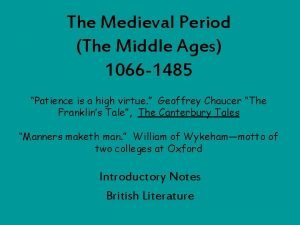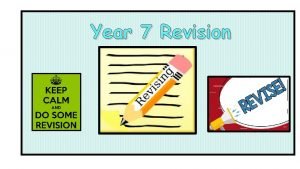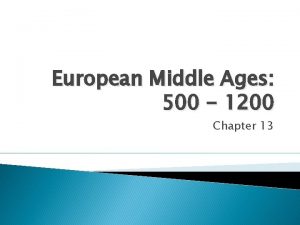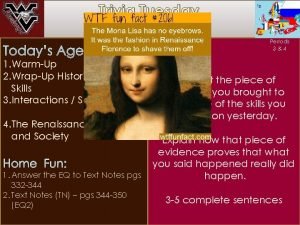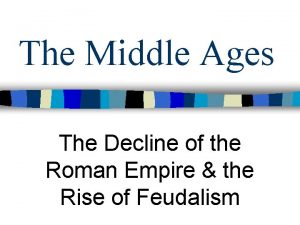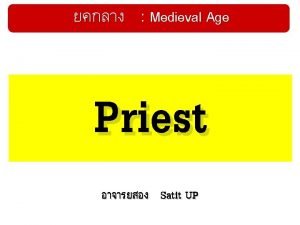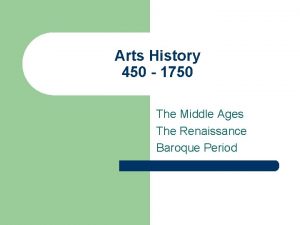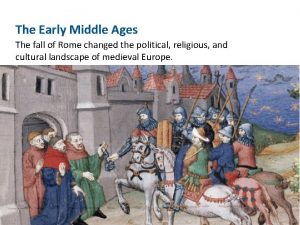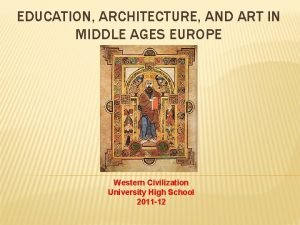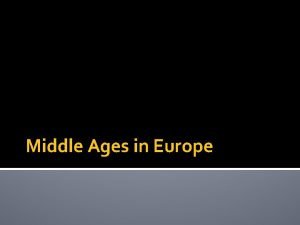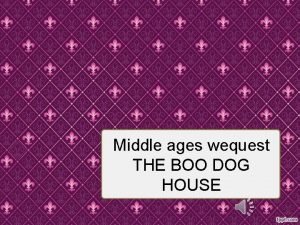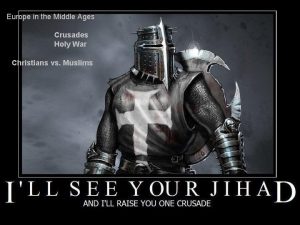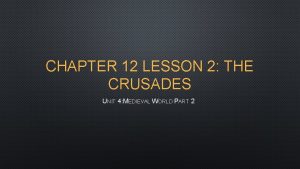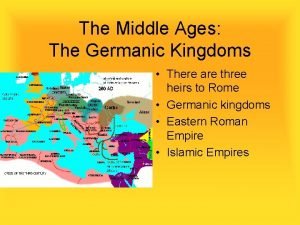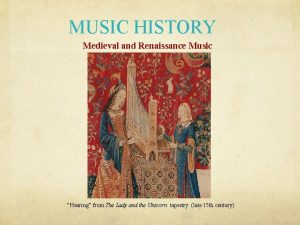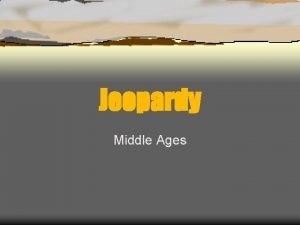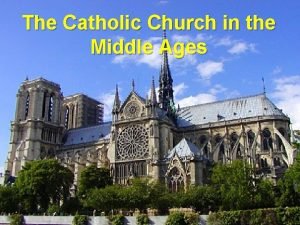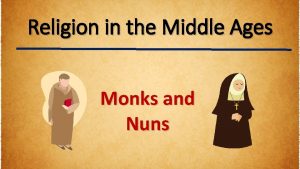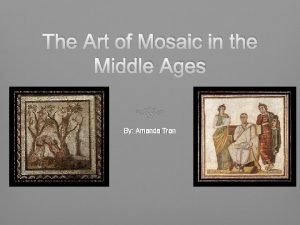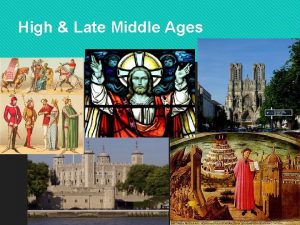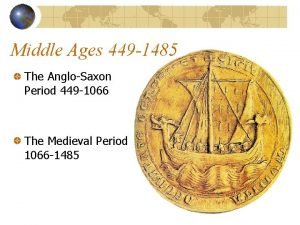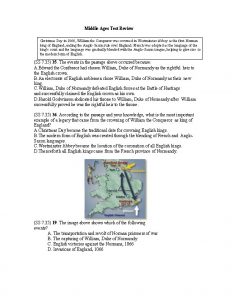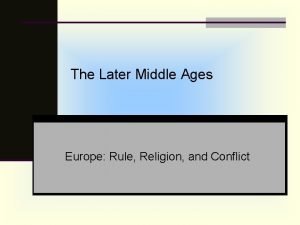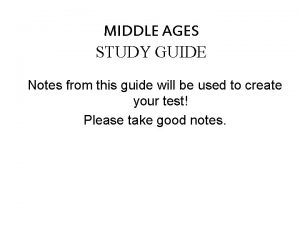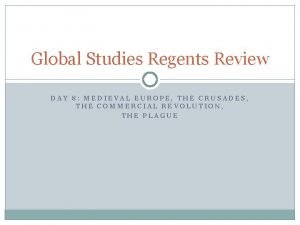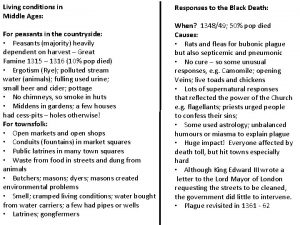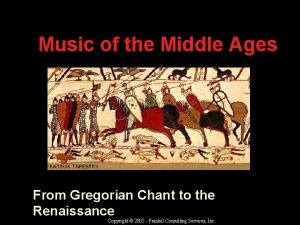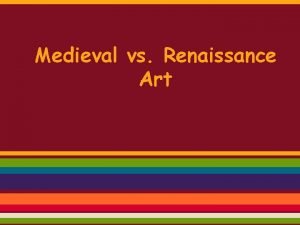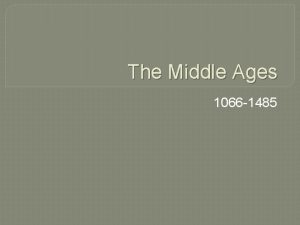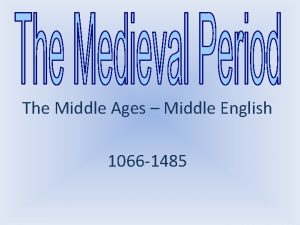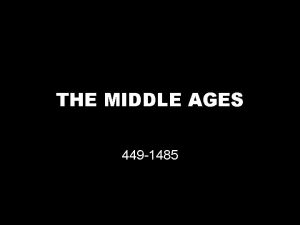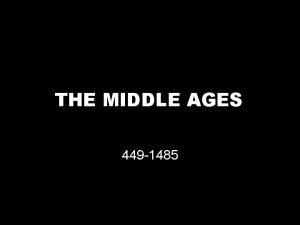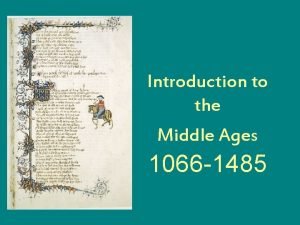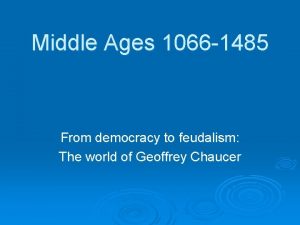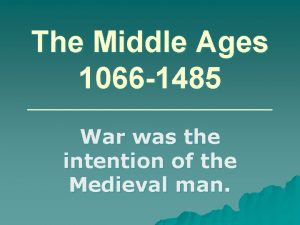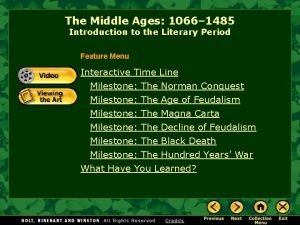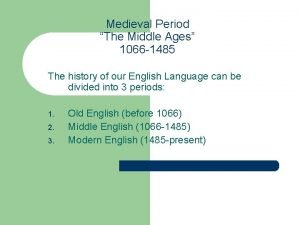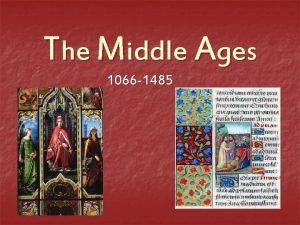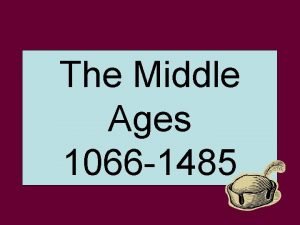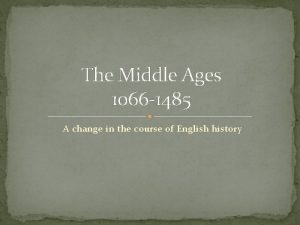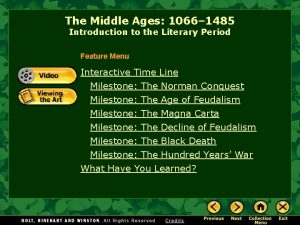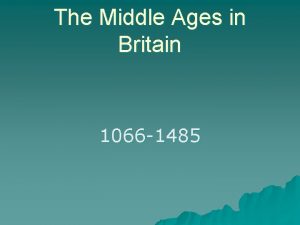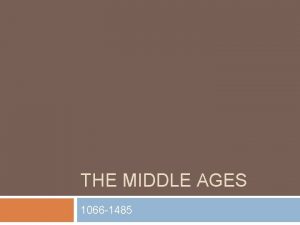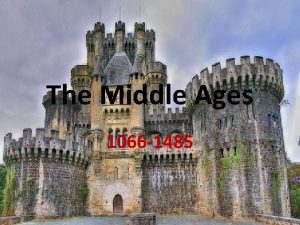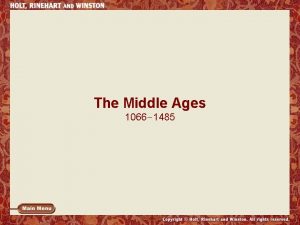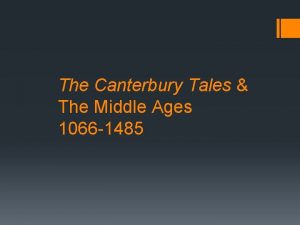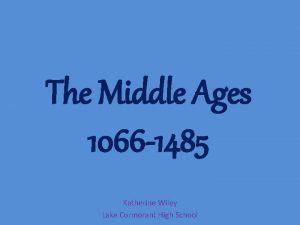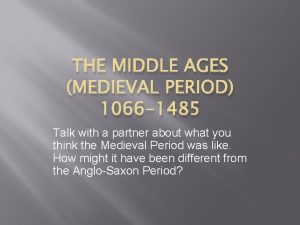The Middle Ages 1066 1485 Edward the Confessor











































- Slides: 43

The Middle Ages 1066 -1485

Edward the Confessor Had no children (which means no heirs to the throne) Died 1066 Anglo-Saxons are now in a shaky position, and King Harold rises to take throne, tentatively.

King Harold Last of the Anglo-Saxon Kings Was the Earl of Wessex (an area covering the southernmost 3 rd of England) Ruled from Jan. 6 th, 1066 to Oct. 14 th 1066. Died in the battle of Hastings • First of only 3 kings to die in warfare.

William the Conqueror Second cousin to Edward Claimed Edward promised the throne to him Illegitimate son of the previous Duke of Normandy Kills King Harold, October 1066 Wanted to rule the Anglo-Saxons, not eliminate them. • Kept Anglo-Saxon language and cultural elements

Normans: Invade at end of 1066 Bought emphasis on law and order Very artistic Cultural unity Administrative ability Domesday Book • Accounting for all property in England • People could be taxed on what they owned

Completed in 1086, printed in Latin. The final judgment of the assessors could not be appealed, hence the name “Domesday” or Day of Judgment.

Feudalism Social, caste, property and military system Based on religious concept of hierarchy God was the supreme overlord • Kings s Had power by “divine right” s Appointed barons/lords s Allotted land for economic and military allegiance Barons/Lords • Could appoint vassals of their own

Feudalism: Knights (warrior caste) Did not own land Military force of barons and kings All males above serf caste Trained as young boys Knighthood was based in a complex system of social codes

Feudalism: Serfs Worked for the economic gain of the baron or king Had protection in return for service


Feudalism: Women No political rights Social standing depended on husbands, fathers, or brothers status Lower class women worked in fields Higher class women ran estates in absence of husbands

Chivalry System of ideal and social codes governing the behavior of knights and gentlewomen Oath of loyalty to lord Rules of warfare • Never attack an unarmed opponent Courtly Love • Non-sexual relationship • Wore lady’s colors in battle • Write poetry about her

Helped to idealize women but did little to improve social positions Gave rise to Romantic genre of literature

City Classes Growth of cities rendered the feudal system obsolete Lower, middle and upper-middle classes • Evident n the writing of Chaucer Merchant class • New interest in art s Mystery and miracle plays • Guilds and craft unions Architecture

Church Hierarchy Just like with the society, the church had its own power structure with God at the top. God Pope Cardinals Archbishops Bishops Priests/Abbotts/Abbesses Monk/Nun

Great Happenings Crusades (1095 -1270) • Christians vs. Muslims s Jerusalem was the prize s Europeans failed • Benefited from contact with high civilized cultures of the Middle East s Mathematics, astronomy, architecture, crafts

Thomas a Becket Norman Prime Minister under King Henry II Appointed arch-bishop, head of the Catholic church in England • King Henry thought Becket would help with disputes with the Pope s Becket sided with Pope – Oops! • 4 of Henry’s knights murdered Becket in the cathedral s Created a backlash against Henry s Thomas was eventually Sainted as a martyr

Magna Carta-“The Great Charter” King John in 1215 Basis for English constitutional law 9 of the 26 provisions in the Bill of Rights can be traced back to the Magna Carta, about a third (33%) Heavily concerned with the right to petition and the due process of law • Trial by jury • Legislative taxation

Hundreds Years’ War (1337 -1453) England against France Based on claims to the throne of France • King Edward III and King Henry V Changed idea of the British • Lost the “Knight in Shining Armor” • Replaced by Yeomen (small landowner) s Used longbows that could pierce armor


Black Death Bubonic plague (1348 -1349) Spread by fleas from rats Decreased population by 1/3 • Causing labor shortage • Gave lower class more leverage • Serfs were given freedom s Knocked out last of feudalism support

Black Death Fun Facts! Estimated 75 – 200 million people died Was called “the Pestilence” Cold weather and rains for 2 years caused a shortage in food, causing people to live closer, ideal for the spread of disease Doctors thought bad smells could cure the plague, or drinking wine.

Black Death continued Bodies were piled up inside and outside city walls where they lay until mass graves could be dug. This contributed to the bad air and helped to spread the disease Bathing during the plague was discouraged for two reasons. 1. Along with changing clothes, it was a sign of vanity, which invited the wrath of God and the punishment of sin. 2. Bathing was believed to open the pores, making it easier for bad air to enter and exit the body, spreading disease.

Black Death continued The attempts to find cures for the plague started the momentum toward development of the scientific method and the changes in thinking that led to the Renaissance. As the population dwindled and society crumbled, old rules were ignored. The Catholic Church lost influence, creating the seeds that led to Protestantism.

So…The Black Death was a good thing? ? ? If nothing else, we get Monty Python!

FUN FACTS ABOUT GEOFFREY CHAUCER

“FATHER OF ENGLISH POETRY” v Prior to Chaucer it was not fashionable for serious poets to write in English, it was all about Latin v Chaucer was a well known government official who served under three Kings—Edward III, Richard II, and Henry IV. v By using the vernacular (everyday language) spoken in London and the East Midlands—Chaucer lent respectability to a language that would develop into the medium for one of the world’s greatest bodies of literature.

LIFE AND TIMES v Born into a middle-class family in London in the early 1340’s v His father was a during wine merchant. He was captured the Hundred Years War in France, but he was important enough that the King contributed to his ransom to get him returned.

FAMILY v. Married Philipa of Hainault in 1366 v. Had at least two children • Thomas became a famous chef, serving royalty • Alice married a Duke • Speculation relations: • Elizabeth Chaucy, a nun at Barking Abbey • Agnes, an attendant at Henry IV's coronation • Lewis Chaucer, Chaucer’s “Treatise on the Astrolabe” was written for him

CAREER v. While he achieved fame during his lifetime as an author, philosopher, alchemist and astronomer, Chaucer also maintained an active career in the civil service as a bureaucrat, courtier and diplomat. v. Later in life he became a member of Parliament

v. Died October 25, 1400 - his tombstone was erected in Westminster Abbey in 1556 and is in the “poet’s corner”

ITALIAN CONNECTION v In 1372 and 1378 Chaucer traveled in Italy where he was influenced by Dante and Petrarch as well as Giovanni Boccaccio. v The framing of The Canterbury Tales and Boccaccio’s Decameron is very similar.

THE CANTERBURY TALES v. He began writing them in 1387 • Never finished v. Written during periods of unemployed (fickle world of politics) v. Uses iambic pentameter: dominant meter is based on ten syllables, unstressed -> stressed pattern

ROAD TRIP! v The story of a religious pilgrimage to St. Thomas a Becket’s shrine v Each traveler is to tell four stories, two going out, and two returning – it’s a contest

THE CANTERBURY TALES – THE PROLOGUE In all of literature there is nothing that touches or resembles the Prologue. It is a concise portrait of an entire nation: high and low, old and young, male and female, lay and clerical, learned and ignorant, rouge and righteous, land sea, town and country! Chaucer is our presumed narrator Starts out at the Tabard Inn in Southwark (south London) Meets 29 religious pilgrims bound for Canterbury This is a fifty-five mile trek and their host suggests a contest for the best storytelling along the way, the prize being dinner.

WANNA TRY IT? LDWA = Long Distance Walkers Association is a group in the UK who still host groups and provide planning info for people to take the journey

OLD ENGLISH & POETRY Remember that there is iambic pentameter in play – an inescapable rhythm to the lines Pronunciation guide on p. 102 Using this guide, figure out how to say the version found on p 104 – specifically the line number corresponding to your desk number

WHEN ENGLISH TEACHERS GET BORED…

IT’S HOMECOMING, CAN WE DO SOMETHING FUN? ? ? • Make sure your Middle Ages Notes and the new vocab are pasted into your IANs. • Next week – the Wife of Bath tells her tale which may ignite a battle between the sexes! • Today: option in lieu of completing the crossword puzzle – create a cheer using three of the word and perform it at the end of class (small groups up to 4) and must include movement.

PROLOGUE - WIFE OF BATH (455 -486) Then there’s a prologue to her own story, p 138

WIFE OF BATH’S TALE

NOW IT’S YOUR TURN Read the Wife of Bath’s Tale starting on p 138

 The middle ages 1066 to 1485 unit test
The middle ages 1066 to 1485 unit test The middle ages 1066 to 1485 unit introduction
The middle ages 1066 to 1485 unit introduction Middle ages unit test answers
Middle ages unit test answers The middle ages 1066 to 1485 unit test closed book
The middle ages 1066 to 1485 unit test closed book Middle english period 1066 to 1485
Middle english period 1066 to 1485 Edward the confessor family tree
Edward the confessor family tree Dark ages def
Dark ages def Renaissance vs medieval art
Renaissance vs medieval art The great schism
The great schism Middle ages def
Middle ages def Dark ages vs renaissance
Dark ages vs renaissance Middle ages
Middle ages Catholic church social pyramid
Catholic church social pyramid High middle ages
High middle ages Sacred music in the middle ages
Sacred music in the middle ages Musical representation of specific poetic images
Musical representation of specific poetic images Early middle ages
Early middle ages Renaissance era floral design
Renaissance era floral design Cathedral art
Cathedral art Middle ages def
Middle ages def During the middle ages noblewomen had
During the middle ages noblewomen had Middle ages
Middle ages The middle ages outcome the power of the church
The middle ages outcome the power of the church Chapter 12 lesson 2 the crusades answer key
Chapter 12 lesson 2 the crusades answer key Germanic kingdoms
Germanic kingdoms The middle ages spans nearly one thousand years
The middle ages spans nearly one thousand years Middle ages jeopardy
Middle ages jeopardy Late middle ages timeline
Late middle ages timeline Middle ages
Middle ages Monks and nuns in the middle ages
Monks and nuns in the middle ages Middle ages
Middle ages Medieval period mosaic
Medieval period mosaic Copyright
Copyright Similarities between middle ages and renaissance
Similarities between middle ages and renaissance A metaphorical phrase used to replace a concrete noun
A metaphorical phrase used to replace a concrete noun Middle ages test review
Middle ages test review How is this
How is this Early middle ages
Early middle ages Middle ages study guide
Middle ages study guide French period flowers
French period flowers What were two indirect results of the crusades
What were two indirect results of the crusades Living conditions in the middle ages
Living conditions in the middle ages Gregorian chant composers
Gregorian chant composers Medieval art vs renaissance art
Medieval art vs renaissance art
